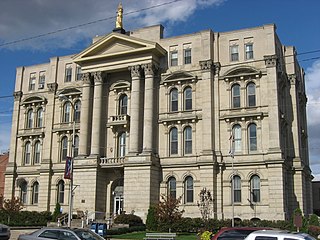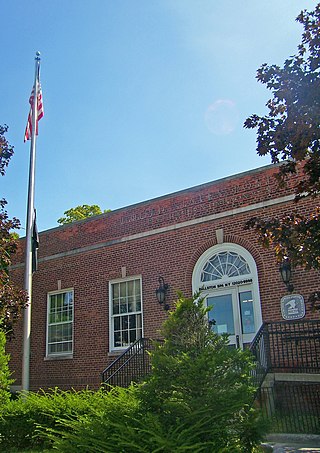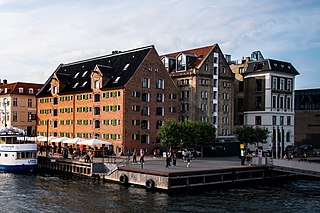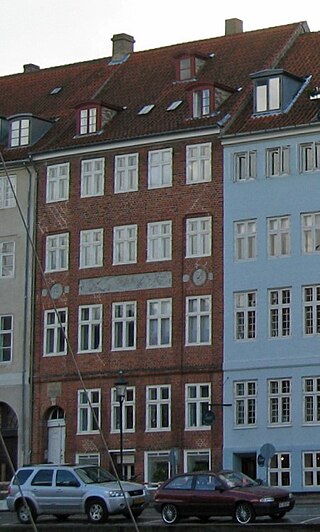
Nyhavn is a 17th-century waterfront, canal and entertainment district in Copenhagen, Denmark. Stretching from Kongens Nytorv to the Inner Harbour just south of the Royal Playhouse, it is lined by brightly coloured 17th and early 18th century townhouses and bars, cafes and restaurants. The canal harbours many historical wooden ships.

Charlottenborg Palace is a large town mansion located on the corner of Kongens Nytorv and Nyhavn in Copenhagen, Denmark. Originally built as a residence for Ulrik Frederik Gyldenløve, it has served as the base of the Royal Danish Academy of Fine Arts since its foundation in 1754. Today it also houses Kunsthal Charlottenborg, an institution for contemporary art, and Danmarks Kunstbibliotek, the Royal Art Library.

The Jefferson County Courthouse is located at 301 Market Street in Steubenville, Ohio. It is the original courthouse constructed for Jefferson County. It was constructed in 1871 through 1874 by Heard & Blythe architectural firm.

The United States Post Office in Peekskill, New York, is located on South Street. It is a brick building in the Colonial Revival architectural style, serving the 10566 ZIP Code, which covers the city of Peekskill and some surrounding areas in the town of Cortlandt.

The U.S. Post Office in Ballston Spa, New York, is located on Front Street in the village's commercial center. It is a brick building constructed in the mid-1930s, serving the 12020 ZIP Code, which covers the village and the surrounding areas of the Town of Ballston, Town of Milton, and Town of Malta

The U.S. Post Office in Granville, New York, United States, is located on Main Street in the center of the village. It is a brick building serving the ZIP Code 12832, which covers the village and surrounding areas of the Town of Granville.

The Keystone Building in Aurora, Illinois is a building from 1922. It was listed on the National Register of Historic Places in 1980. The structure is one of two buildings on Stolp Island designed by George Grant Elmslie, the other one being the Graham Building. In addition, there are three other buildings within Aurora that share the same architect, making Aurora, Illinois the biggest collection of Elmslie's commercial buildings.

71 Nyhavn is a high-end hotel based in two converted warehouses on the corner of the Nyhavn Canal and the main harbourfront of Copenhagen, Denmark. It has 150 rooms and is after an upgrade completed in 2018 Apr-Hansen Hotel Group's most expensive hotel.

The Copenhagen Amber Museum is a museum on Kongens Nytorv in central Copenhagen, Denmark. The museum is owned by House of Amber. The museum holds an extensive collection of amber antiques and artifacts, including a wide array of entombed insects from prehistoric times. The collection comprises one of the largest piece of amber in the world.

The Peterborough Main Post Office is located at 23 Grove Street in Peterborough, New Hampshire. Built in 1936, it is a well-preserved example of Georgian Revival architecture. It is further distinctive because it is virtually unaltered since its construction, and its interior features a WPA mural by Marguerite Zorach. The building was listed on the National Register of Historic Places in 1986.

The Wilton Public and Gregg Free Library is the public library of Wilton, New Hampshire. It is located in a Classical Revival brick building on Forest Street, near the north end of Wilton's downtown area. The building was designed by the Boston, Massachusetts, firm of McLean & Wright, and built 1905-07. It was a gift of David Almus Gregg, a local manufacturer of building parts; Gregg further gave the library an endowment in 1912. It was listed on the National Register of Historic Places in 1982.

The British Residency, also known as the Government Guest House or Residency Bungalow, is a two-storeyed palace situated at Asramam in the city of Kollam in the Indian state of Kerala. It lies close to the site of the old Kollam Airport situated at Asramam in the city and was built by Colonel John Munro between 1811 and 1819. It is a noted Kollam landmark like the Chinnakada Clock Tower.

Nyhavn 37 is an 18th-century property overlooking the Nyhavn Canal in central Copenhagen, Denmark. The building was listed in the Danish registry of protected buildings and places in 1923.

Nyhavn 20 is a 17th-century building overlooking the Nyhavn canal in central Copenhagen, Denmark. It was listed in the Danish registry of protected buildings and places in 1945. The building houses a bar in the basement and a residential apartment on the upper floors. The facade features a relief of a fish above the main entrance, flanked by two reliefs of sailing ships.

Nyhavn 61 is an 18th-century residential building overlooking the Nyhavn canal in central Copenhagen, Denmark. The building was listed in the Danish registry of protected buildings and places in 1945. The scope of the heritage listing was expanded in 1984. Nyhavn 61 and Nyhavn 59 have now been merged into a single property and are physically integrated on the third floor. The two buildings share a central courtyard.

Nyhavn 5 is an 18th-century property overlooking the Nyhavn canal in central Copenhagen, Denmark. It was listed in the Danish registry of protected buildings and places in 1945. Notable former residents include the actor Adam Gottlob Gielstrup, opera singer Peter Schram and businessman Cornelius Peter August Koch.

Nyhavn 21/Lille Strandstræde 4, formerly known as Hotel L'ven, Hotel Kronprinsen and Fredsfondens Hus, is a complex of historic buildings overlooking the Nyhavn canal in central Copenhagen, Denmark. It consists of a late 17th-century building in Nyhavn and a just two bays wide building in Lille Strandstræde as well as a two-storey rear wing from 1748. It was listed in the Danish registry of protected buildings and places in 1945. The restaurant Cap Horn was a popular jazz venue in the 1950s. It is now part of the Tholstrup restaurant group. Notable former residents include the politician Jens Christian Christensen and painters Anna and Michael Ancher.

Nyhavn 8 is an 18th-century property overlooking the Nyhavn canal in central Copenhagen, Denmark. It was listed in the Danish registry of protected buildings and places in 1918. A sandstone tablet with inscription above the arched main entrance commemorates a time when Dragør skippers used to stay in the building during the winter months.

Nyhavn 17 is a late 17th-century building situated at the corner of Nyhavn and Lille Strandstræde in central Copenhagen, Denmark. It was listed on the Danish registry of protected buildings and places in 1951.

Kvæsthusgade 1, also known as, Nyhavn 69 is a three-storey building situated at the corner of Nyhavn and Kvæsthusgade. A memorial featuring a bust of a diver wearing a diving helmet commemorates that Em. Z. Svitzer's Bjernings-Enterprise, a salvage company founded by Emil Zeuthen Svitzer back in 1833, was once headquartered in the building. Notable former residents include the actress Magda von Dolcke.
























